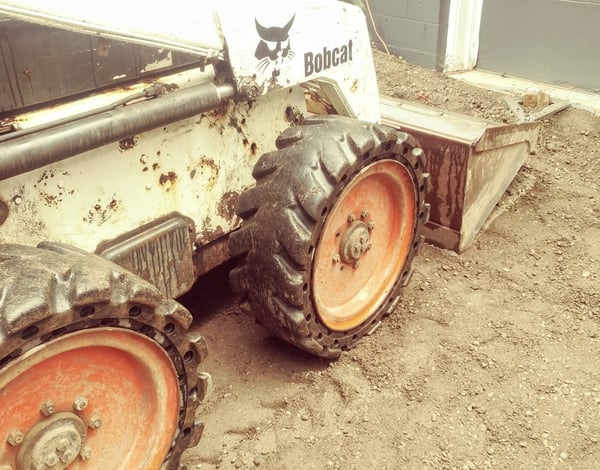A skid steer loader or sometimes referred to as a bobcat is one of the most used equipment used across a range of different projects, from residential to commercial and government. With the machine being rapidly available it is often available for sale as operators and suppliers update their fleet regularly. Additionally, if you require the skid steer loader for long-term hire a proper inspection needs to be completed. We have compiled a list of items you should check out when it comes to inspecting a skid steer loader. Failure to inspect the machine correctly and this could be a costly mistake.
Hire a skid steer with confidence
Before making your decision to purchase or long-term hire a skid steer loader do a proper inspection and check the following 5 inspection tips.
Top 5 inspections tips

1) Inspecting the historical records
When inspecting the skid steer it is important to uncover as much historical information about the skid steer. This would include the log hours, maintenance records, and previous use as this would determine whether you purchase or hire the machine.
Reviewing the log hours will determine the daily operational hours of the skid steer loader as well as components that are nearing replacement or maintenance. Reviewing the maintenance record will provide you with key information on the maintenance of the machine and the overall condition. An up-to-date maintenance record will also provide you with all the information you need to make a decision.
Reviewing the log hours and maintenance records will provide you with key information for your purchase or hire. Get historical with the previous owners on how the machine was used in the past and the jobs that it has completed as different jobs can determine different wear and rear. An example of this would be if it was used in harsher environments such as construction sites which could shorten the lifespan of the machine.
2) Inspecting the canopy or cab
Check the canopy or ROPS (rollover protection structure) for any damages or bends. This is crucial as it could have effects on the ability of protection in case of an accident. Additionally, if the skid steer has an enclosed cab, check that the windows are not damaged or missing.
3) Inspect the bucket, loader arms and cylinders
When inspecting the bucket asses the buckets leading edge, side panels and bottom. Check closely for signs of wear, welds or other repair work on the leading edge, the condition of the bottom and the thickness of the side panels. Once you have inspected the bucket, assess the loader lift cylinders and if there are any cracks or leaks. Finally, check the loader arms for any cranks, bends and welds. If cracks and bends are noticeable on the skid steer this is a sign that the machine could have previously been rolled or pushed beyond its capacity. While a weld on the loader arm can indicate a crack that has been repaired.
4) Inspect wheels and tyres
When inspecting the tyres it's worth reviewing the log book on how many operational hours the machine has done. Generally, if the skid steer has done over 500 hours the tyres begin to show signs of excessive wear. Assess if the tyres are properly inflated and no signs of leaks or damages and that all lug nuts on wheels are tight.
5) Hydraulic system, engine and under the machine
Finally, inspect the hydraulic system, engine and under the machine. When assessing the hydraulics inspect for excessive moisture. Open the rear engine component and assess any signs of leaks, cracks in hoses, dirt buildup, condition of the oil and the level of oils. Additionally, check if the belts are tight and cracked or worn out, and if the air filter is clean. Finally, have a look under the machine for any excessive pools of oil or hydraulic fluid on the ground. This will all determine how well the skid steer loader has been maintained and the working order of the machine. Refer to the maintenance records as this will indicate all the maintenance and servicing of the machine that was done in the past.
Now that we have gone through the initial 5 steps to inspecting a skid steer loader we also recommend bringing your own qualified mechanic or an experienced operator, particularly when purchasing the machine. This is to avoid missing some key areas when inspecting which could potentially add unnecessary costs to your purchase. Additionally, we recommend doing a test drive as you will be able to test the workings of the machine.
We would also recommend bringing your mechanic or do a test drive if possible. This will allow you to see how well the skid steer works and provide you with peace of mind when purchasing or long-term hiring.
If you are wanting to buy a second-hand skid steer we recommend checking out an auctioneer such as Graysonline, who are one of Australia’s largest auctioneers when it comes to heavy machinery. They do weekly auctions across Australia on all different heavy machinery. Additionally, if you require finance we recommend checking out Finlease .
If buying is not what you are looking for and would like to hire the machine for short or long term then get rates in minutes from iseekplant. We are Australia’s largest marketplace when it comes to hiring skid steers. We have suppliers and operators across Australia including all the major cities such as Brisbane, Sydney, Melbourne, Adelaide, Perth, Darwin, Hobart, Canberra, and all the regional areas. Get in touch with us on 1300 691 912, otherwise use the iseekplant get a quote tool today! Subscribe to iseekplant's Contructionsht Blog today to keep up to date with the latest industry news and projects across Australia!


